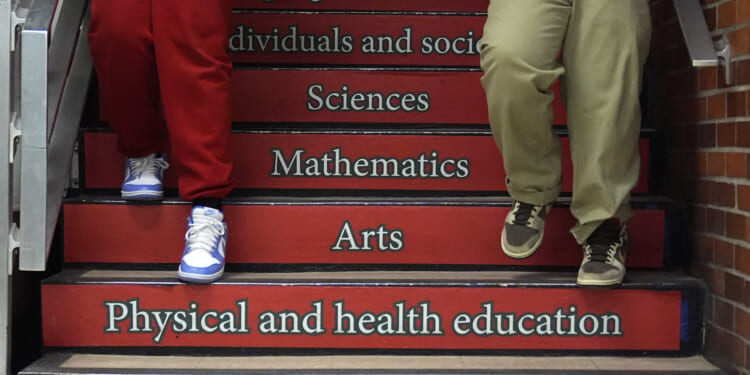There are 9,081 fewer students enrolled in Chicago Public Schools, driven by declines in Black and Hispanic students. The big drop ends a blip in annual enrollment declines.
After two school years of modest enrollment increases following over a decade of declines, Chicago Public Schools is once again losing students.
There are 316,224 students enrolled in CPS this school year, according to its new enrollment report. That’s a drop of 9,081 students, with Black and Hispanic students making up the largest declines.
CPS experienced 11 years of enrollment declines from 2011 to 2022, dropping from third- to fourth-largest school district in the country in 2022. While 2023 and 2024 indicated a potential shift away from Chicago’s decades-long enrollment decline, this school year’s data shows those modest increases were a mirage, largely because of an influx of migrant students.
Over 1-in-3 desks were already empty in CPS last school year, with many schools much emptier – including a high school built for 900 students that contained only 28. The new enrollment declines mean even more empty seats and near-empty school buildings at higher costs per student.
Families have been ill-served by CPS as evidenced by students’ low proficiency rates in reading and math. CPS must help students achieve if it hopes to stop the enrollment declines.
A closer look at CPS enrollment
This school year’s decline in enrollment returns CPS to its previous decades-long trend of enrollment losses. While enrollment rose slightly in 2023 and 2024, the previous 11 years each saw drops totaling nearly 81,000 students.
Now the declines have returned, with CPS losing over 9,000 students this fall from the 2024 fall count.
The decline in enrollment was driven largely by a decrease in Hispanic and Black students in CPS. The largest drop – and largest change overall – came from Hispanic students with nearly 7,000 fewer enrolled. The next largest decline came from Black students with nearly 2,900 fewer enrolled.
While Black and Hispanic student enrollment decreased, the number of white students increased by 499 kids. Asian student enrollment also rose by 265 students.
Poor student outcomes won’t attract students
The most recent test scores show few students are meeting grade-level standards in reading and math.
Among third- through eighth-grade students, just 31% could read at grade level and 18% could perform math proficiently districtwide in 2024. That’s about 10 percentage points below the state average in both subjects.
Among 11th-grade students, only 22% could read at grade level and only 19% were proficient in math on the SAT, which measures proficiency for high school students. That’s 9 percentage points below the state average in reading and 7 percentage points lower in math.
While the low proficiency rates districtwide are concerning, an added concern is the even greater rate at which low-income students and minority students are struggling to reach proficiency in reading and math.
Chronic absenteeism also remains high after it spiked in 2022 following pandemic-related school closures. In 2024, the most recent data available, about 41% of CPS students were chronically absent. That means they missed 10% or more of the school year, with or without an excuse.
High absenteeism is a warning sign for students, as research suggests frequent absences from school put students at a higher risk of dropping out of school, lower academic achievement and other harms.
District spends more for fewer students
Despite such poor outcomes, CPS continues to operate on larger budgets as both operating revenues and spending continue to hit all-time highs.
Operating revenues for the district will top $8.6 billion for the first time in history for the 2025-2026 school year. That’s expected to be nearly $60 million more than last year’s budget.
Expenses are also growing. Nearly $1.7 billion of the increase in expenditures – 70% – from 2020 to 2025 have been for salaries or benefits for employees. Despite declining enrollment, CPS has added nearly 8,000 additional staff during that time.
Enrollment declines threaten to worsen CPS’ empty school problem
On average, over 1-in-3 desks are empty in CPS but many schools are much emptier, according to data from the 2024-2025 school year.
This isn’t a new problem for the district. A 2018 CPS board policy sought to address under-enrolled schools, but that was years ago and hundreds of school buildings remain too empty.
Space utilization is measured annually by the district. It then reports on the data, splitting the schools into three categories: underutilized, efficient or overcrowded. An elementary school’s ideal capacity is 77% of its maximum capacity and a high school’s is 80%.
The average “space utilization rate” in the 2024-2025 school year is 65% across 474 single-location schools analyzed from district data. That means the average school in CPS has 35% of its seats empty.
But that was before the newest drop of over 9,000 students in CPS.
CPS must find cost-saving measures, but costly CTU contract makes it difficult
CPS is inefficient: many buildings are half empty, some nearly empty such as Douglass Academy High School where 28 were housed in a 900-student building. Staffing numbers increased despite decreasing numbers of students during the past decade.
In the face of the district’s financial hardships and inefficiencies, CTU leadership ratified a new contract with CPS this summer, estimated to add $1.5 billion to district expenses over four years. Among the provisions is the addition of more staff members.
Cost-saving measures will be needed to fix CPS’ financial outlook amid continued student losses. With deficits consistently hanging over the district and enrollment dropping, all cost-saving options should be pursued.










